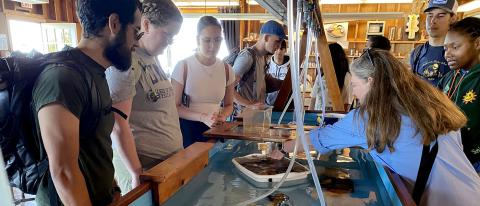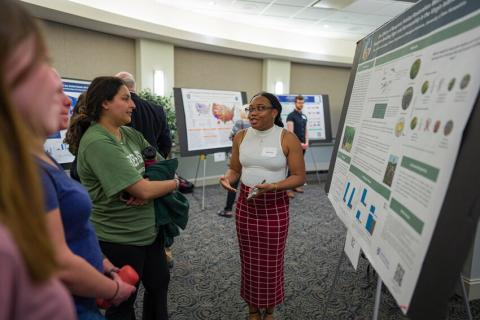
REU: Sensors in Earth, Oceans, and Space Science –
How We Observe Our Planet
Our primary goal is to provide a positive introduction to sensor-based Earth and space science research for underserved student populations.
What makes this REU program unique?
- Research opportunities in Earth, Oceans, and Space: Sensors are used across many fields of Earth, Space and Ocean sciences. This REU program is hosted by UNH’s Institute for the Study of Earth, Oceans, and Space, providing research projects and mentors in all three of these scientific fields.
- Focus on sensors and cutting-edge data science skills: Learn to harness the data revolution! In this REU, you will develop skills to collect, analyze, and interpret data from a wide range of sensors used in science. This includes sensors deployed in ocean settings, forests, rivers, and even satellites in space. Data analysis using programming and statistics are core skills taught by leading scientists.
- Professional development activities: In addition to learning scientific research skills, you will present a research poster to peer researchers at a multi-internship end of summer symposium. This REU will also provide weekly lunch discussions with scientific professionals in academia, industry, and government, giving you a chance to learn about the myriad career pathways opened by STEM degrees.
- Open to students of all levels and majors: This REU is open to undergraduate students of all levels and majors, including undecided/undeclared majors.
Important dates for 2026 REU
Program Dates
June 1 – August 7
Application Deadline
February 6
Matchmaking Interviews
February 2026
Acceptance Notice
March 2026
If you have technical difficulties with the NSF ETAP application website, you can apply by emailing:
- The Application document
- Your resume
- Two reference letters
To: EOS.REU@unh.edu
or Danielle.Grogan@unh.edu
By: Thursday, February 6, 2026
(midnight applicant's time)
Frequently Asked Questions

What is an REU program and is it right for me?
An REU is a “Research Experience for Undergraduates,” and is a program sponsored by the National Science Foundation. The goal of all REU programs is to provide authentic research experiences for undergraduate students. Here, we aim to help students identify if STEM majors and careers are right for them. You can find more information on all REUs and search for other REU programs here.
What will I do as part of this REU?
Each student will work on a specific project with a faculty mentor. See below for project descriptions and mentor profiles. Over the course of 10 weeks, you will learn about the research questions that can be addressed by the type of sensors used in your mentor’s lab, how to collect, maintain, and analyze data, and finally how to present your findings to peers. Many projects will involve computer programming skill building, and some will include field and/or lab work. You will also learn about data stewardship, research integrity, and collaborative science. REU students will work alongside graduate students, post-doctoral researchers, and other scientific professionals.
Where is this REU located?
The University of New Hampshire main campus in Durham, NH. All REU students will have housing on campus, and mentor labs are all in UNH’s Institute for the Study of Earth, Oceans, and Space. Some projects may involve field work off-campus; transportation will be provided for all required fieldwork.
Will I be compensated for participating in this REU?
Yes! This REU program provides on-campus housing, meals, and a $6,000 stipend for each student.

Am I eligible to apply to this REU?
Applicants must be U.S. citizens or permanent residents and at least 18 years of age at the time of the REU program. This REU program is open to all majors – including undecided or undeclared majors – as well as undergraduate students at all levels of study (freshman, sophomore, etc). We welcome applications from students in 2-year courses of study. The main goal of this REU program is to provide research experiences to underserved student populations. This includes underrepresented minority groups in STEM, veterans, individuals with differing abilities, and people from low socioeconomic status. Underrepresented minority groups in STEM are defined by the NSF as: Blacks and African Americans, Hispanics and Latinos, and American Indians including Alaskan Natives and Native Pacific Islanders.
Projects and Mentors
Marine microbes cover a diversity of organisms that account for more than 98% of ocean biomass. They are fundamental for oceanic food webs and thus ecosystem function and services. Research within the Ocean Process Analysis Laboratory aims to understand microbial and biogeochemical processes and their role in the cycling of growth-limiting nutrients (e.g., nitrogen and phosphorus) as well as organic and inorganic carbon in marine environments. REU students will be involved with field measurements in the Gulf of Maine and its estuaries, and with laboratory research focusing on microbial growth and metabolic rates along with carbon chemistry, and how these rates and parameters are affected by anthropogenic stressors such as ocean acidification, sea surface warming, and ocean pollutants (e.g., microplastics, spilled oil). Students will gain skills in marine sensor deployment, lab incubation methods, and statistical data analysis.
Mentor: Dr. Kai Ziervogel
Seagrasses are important ecosystems that help mitigate climate change, clean the water, and support local fisheries and biodiversity. Globally, these sensitive ecosystems are in decline, with numerous international efforts attempting to monitor their health and evaluate the effectiveness of conservation programs. As seagrasses photosynthesize and sway in currents, underwater sound and surface cameras can be used to monitor their health. Research within 3 centers: CARE (Center for Acoustics Research and Education), CCOM (Center for Coastal and Ocean Mapping), and SMSOE (School of Marine Science and Ocean Engineering) aims to understand the relationship between hydrodynamics and underwater acoustics in seagrass beds, enabling the design of better sensor-based seagrass health monitoring systems. To better study this complicated interaction, researchers are using a model seagrass bed seeded with bubbles in a 10-m-long flume in the laboratory. REU students will be involved with running the flume and collecting acoustic and hydrodynamic data. They will gain skills in the processing and interpretation of acoustic and hydrodynamic signals.
Mentors: Dr. Gabriel R. Venegas
Marine pathogens spread quickly and can decimate important coastal ecosystems like seagrass meadows and coral reefs. The loss of ecosystems impacts coastal communities and economies that rely on these marine organisms and their ecosystem services. In this project, students will explore how the flow of water can drive the spread of these diseases, either by causing plant-to-plant contact in seagrass meadows or by transporting tissue fragments or sediment between diseased corals. This project will use synthetic physical systems and a laboratory flume to study the physics of disease spread. Students will gain skills in 3D solid modeling or 3D printing, quantitative imaging, and data analysis.
Mentor: Dr. Tracy Mandel
Estuaries – where rivers meet the ocean – are hotspots for biodiversity, as well as early indicators of water contamination issues and climate change impacts. Piscataqua Region Estuaries Partnership (PREP) researchers within SMSOE use a suite of in-situ water sensors along with surveys of seagrass coverage and indicator species (shellfish, green crabs, lobster, and oyster reefs) to help monitor estuary ecosystem health and develop best management practices for nutrient pollution. The PREP organization helps communities around UNH better manage their two estuaries of national significance: the Hampton-Seabrook Estuary and the Great Bay Estuary. Due to its community focus, PREP’s expertise and student training includes participatory process design and facilitation, and science communication. REU students will collect and analyze data from estuary in-situ sensors. Skill development includes not only data analysis, but also community outreach and science communication.
Mentor: Dr. Kalle Matso and Dr. Bror Jonsson
The seafloor is a complex environment that is composed of many types of sediment, home to many types of organisms, and is constantly changing. Increasingly, man-made objects are left on the seafloor both intentionally and unintentionally. Our most effective way to understand the seafloor is by transmitting acoustic signals and listening to the echoes. Interpreting these echoes is still challenging because of the complexity of the underwater environment. This project is investigating acoustic sensors and signal processing to better understand echoes from the seafloor. REU students will be involved with field measurements and laboratory experiments that support several research projects in the Center for Acoustics Research and Education and the Center for Coastal and Ocean Mapping. Skill development will include acoustic signal processing, instrumentation and electronics, and science communication.
Mentor: Dr. Tom Blanford
Oil is an ancient fossil fuel that we use to heat our homes, generate electricity, and power large sectors of our economy. But when oil accidentally spills into the ocean, it can cause big problems. Research in the Kinner lab focuses on validation and calibration of various remote sensing technologies (RSTs) to determine oil slick thicknesses in a controlled laboratory setting. RSTs include overhead Unmanned Aerial System (UAS) based sensors, surface samplers, and underwater sensors. Student interns would validate and calibrate RTSs at an outdoor facility that includes totes, troughs, and pools which will contain slicks of known oil thickness and overflights will be conducted periodically throughout the day while environmental factors (light level, water and air temperature) are continuously monitored. The influence of environmental factors on the signals observed from the sensors will be investigated to identify potentially useful relationships applicable to oil spill responders.
Mentor: Dr. Nancy Kinner
Water resources are essential to all human activities, from feeding the global population to industrial production. Prior to the satellite era, water resource data was collected with inconsistent methods, quality, and density across different regions of the world. Now, researchers in the Earth Systems Research Center use cutting-edge satellite data to observe many important components of the water cycle and human water use consistently across the globe, including changes in groundwater storage, soil moisture, snow and glacier cover, reservoir water levels, and even irrigation infrastructure. These data, in combination with statistical analysis and hydrologic modeling, can answer such questions as: is snow cover changing in regions that rely on snowmelt to supply irrigation water? How much does agricultural production rely on nonrenewable groundwater resources? Is groundwater pumping contributing to sea level rise? These questions are essential to the multiple ongoing Earth Systems Research Center research projects that focus on applying Earth sensor data to the United Nation’s Sustainable Development Goals. REU students will use global satellite observations to understand how water resources are changing through space and time across the entire planet, with a focus on Sustainable Development applications. Skill development will include satellite data processing, hydrologic modeling, and statistical analysis.
Mentor: Dr. Danielle Grogan
Our technology-driven society is dependent upon satellite technology for communication, navigation, and national security, as well as upon a reliable power grid for everyday needs such as money transactions, job functions, and food storage. These infrastructure systems are vulnerable to geomagnetic activity, when charged particles in the space surrounding Earth are energized and transported due to energy input from the Sun. Researchers in the Space Science Center use satellite data to create ion temperature maps of the magnetosphere, which help to understand where and how ions are heated by the energy from the Sun and how they’re propelled towards Earth. Emerging machine-learning methods are being tested to evaluate their ability to use satellite sensor data to model geomagnetic storms and predict when these disruptions will cause power outages. REU students in the Space Science Center will join in the creation of ion temperature maps from satellite sensor data, as well as test new machine learning models. Skill development will include satellite data processing, 3D map making, and machine learning methods.
Mentor: Dr. Amy Keesee and Dr. Matthew Argall
